An international group of research scientists has come together to challenge ICNIRP, the International Commission on Non-Ionizing Radiation Protection.
The new panel wants a complete revision of ICNIRP’s guidelines for exposures to radiofrequency (RF) radiation. The researchers are demanding the adoption of more scientifically rigorous standards, which better protect public health and the environment.
“We are calling for an independent evaluation of the limits,” Joel Moskowitz of Berkeley Public Health, an arm of the University of California, told Microwave News. This needs to be done, he said, because ICNIRP’s guidelines are “based on smoke and mirrors.”
Moskowitz is one the organizers of the new group of scientists, which calls itself the International Commission on the Biological Effects of EMF (ICBE-EMF). Among its 11 principals or Commissioners are Henry Lai and Ronald Melnick of the U.S., Igor Belyaev of Slovakia and Suleyman Dasdag of Turkey (full list below). Moskowitz is one of the new panel’s eight “special experts,” as are Sweden’s Lennart Hardell and Wenjun Sun of China.
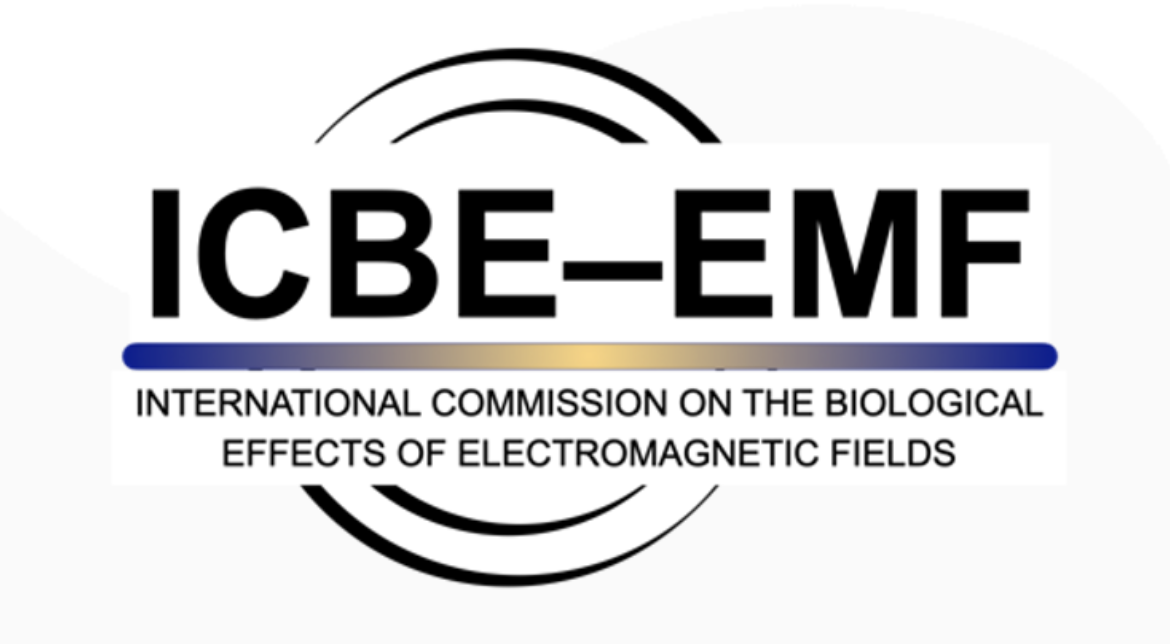
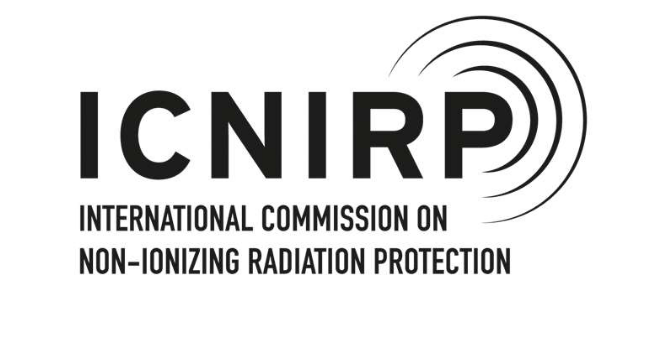
ICBE-EMF is promoting precautionary policies to minimize potential adverse effects, especially for children, pregnant women and those with EM hypersensitivity (EHS). ICNIRP has ignored them.
ICNIRP, founded by Michael Repacholi in 1992, issued its first set of exposure guidelines in 1998. They were last updated in 2020. The ICNIRP limits are now the most widely-used metric for assessing radiation safety.
14 False Assumptions
ICBE-EMF’s opening salvo is a peer-reviewed paper with a detailed deconstruction of 14 assumptions that, it states, are “inherent” in ICNIRP’s RF radiation guidelines. The paper, which runs 25 pages with 230 references, was posted by the journal Environmental Health on October 18.
The fallacies at the heart of these 14 assumptions, ICBE-EMF argues, have led ICNIRP to adopt limits that are “wrong” and that “fail to protect public and environmental health.”
The first and most important of these assumptions is that adverse health effects are caused only by heating and only by exposures above an SAR of 4 W/Kg. The second is that RF radiation cannot damage DNA without causing tissue heating. All 14 assumptions are spelled out in the table below.
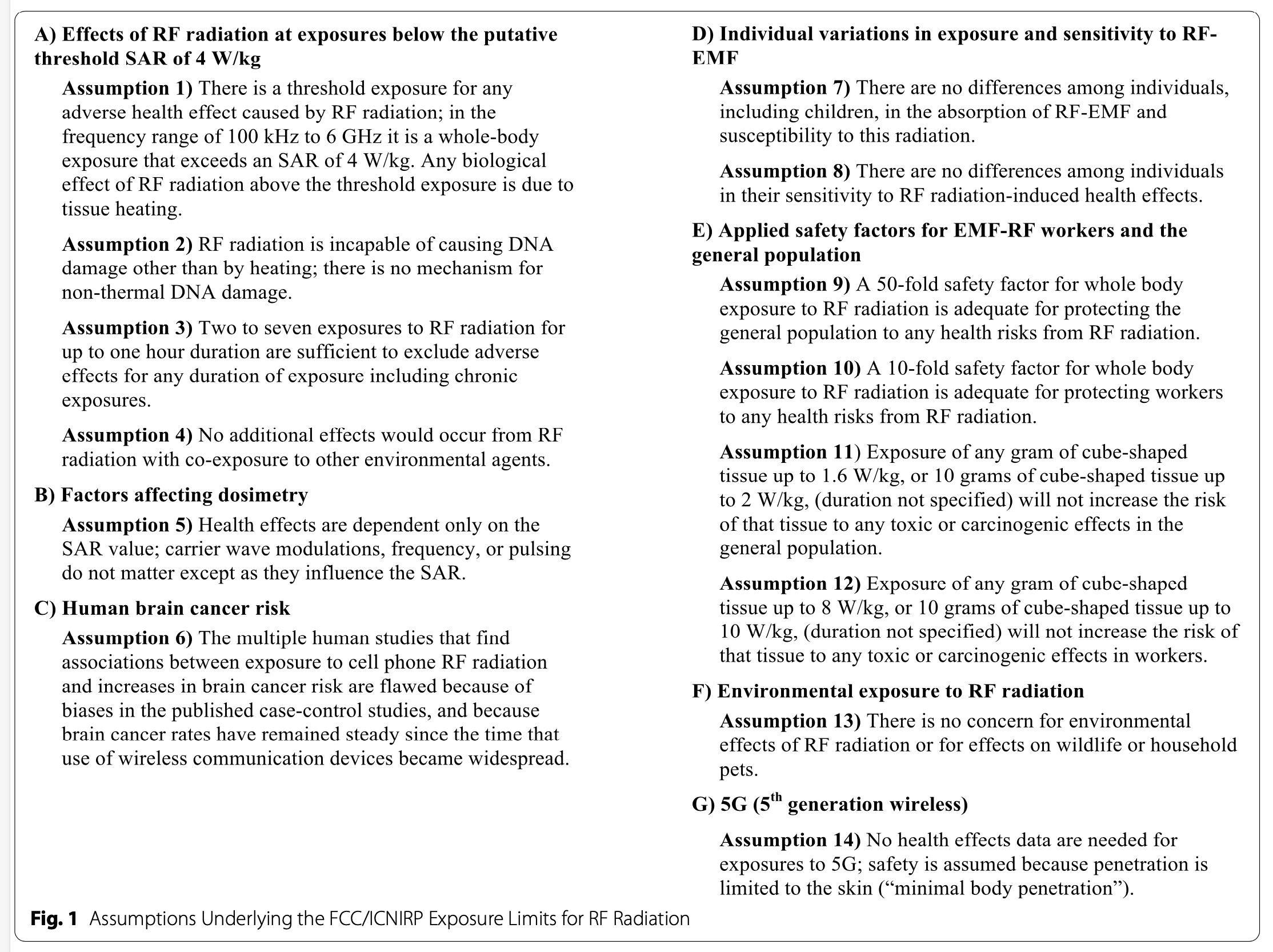 14 Assumptions Underpinning ICNIRP’s Guidlelines
14 Assumptions Underpinning ICNIRP’s Guidlelines
Click to enlarge. From Environmental Health, 2022, p.3.
The 4 W/Kg threshold for ill effects is now over 40 years old. It was first endorsed by the American National Standards Institute (ANSI) in 1982 and has remained unchanged since then. ICNIRP used 4 W/Kg for its first set of exposure guidelines, issued in 1998, and it has remained the basis for most RF–exposure standards in Western countries, including those used by the U.S. FCC. When ICNIRP updated its guidelines in 2020, it kept the 4 W/Kg threshold.
As ICBE-EMF points out in its new paper, the 4 W/Kg threshold was derived from just a couple of studies that investigated behavioral effects in a small number of animals following short-term RF exposure. ICNIRP has never made any allowance for possible effects due to long-term exposures.
A supplementary table (Appendix 1) lists 131 experimental studies that found RF-induced oxidative stress below 4 W/Kg.
Melnick took the lead in writing the paper, with substantial contributions from the other ICBE-EMF Commissioners and their advisors. Melnick, now an independent consultant, worked for nearly 30 years, until 2008, at the U.S. National Toxicology Program (NTP) where he designed the protocol for its $30 million project on wireless radiation.
When the study was completed, the NTP concluded that it showed “clear evidence” of cancer among rats exposed to wireless radiation. ICNIRP was not swayed: It called the NTP findings unconvincing. ICNIRP deemed the study insufficient to recommend precaution.
No Response from ICNIRP
The editors at Environmental Health offered ICNIRP the opportunity to publish a reply in the same issue of the journal as the ICBE-EMF paper —if the journal received a manuscript within 30 days. ICNIRP declined.
“We would have liked to respond, but we decided not to,” Eric van Rongen, the vice chair of ICNIRP, told Microwave News. “It would have cost a lot of time,” he said, “and we preferred spending that on our actual tasks.” Van Rongen recently retired after a long career at the Health Council of the Netherlands.
Following in the Footsteps of ICEMS
Old hands in the RF community have seen this play out before. Twenty years ago, a similar group of dissident scientists formed an association which sought to counter ICNIRP’s then-emerging hegemony on EMF/RF exposure standards. That organization was very much like ICBE-EMF and had a nearly identical name: the International Commission on Electromagnetic Safety, or ICEMS for short. Three of its founders are now helping ICBE-EMF get off the ground.
ICEMS was conceived in September 2002 at a conference held in Catania on the east coast of Sicily. It was formally registered as a non-profit in Venice the following year. ICEMS’ guiding principles were laid out in the Catania Resolution — it runs just a few paragraphs but offers a message not unlike ICBE-EMF’s 25-page paper.
“There are plausible mechanistic explanations for EMF-induced effects which occur below present ICNIRP” guidelines, the Resolution states (see below). It was signed by 18 scientists, including ICBE-EMF’s Carl Blackman, Henry Lai and Lennart Hardell.
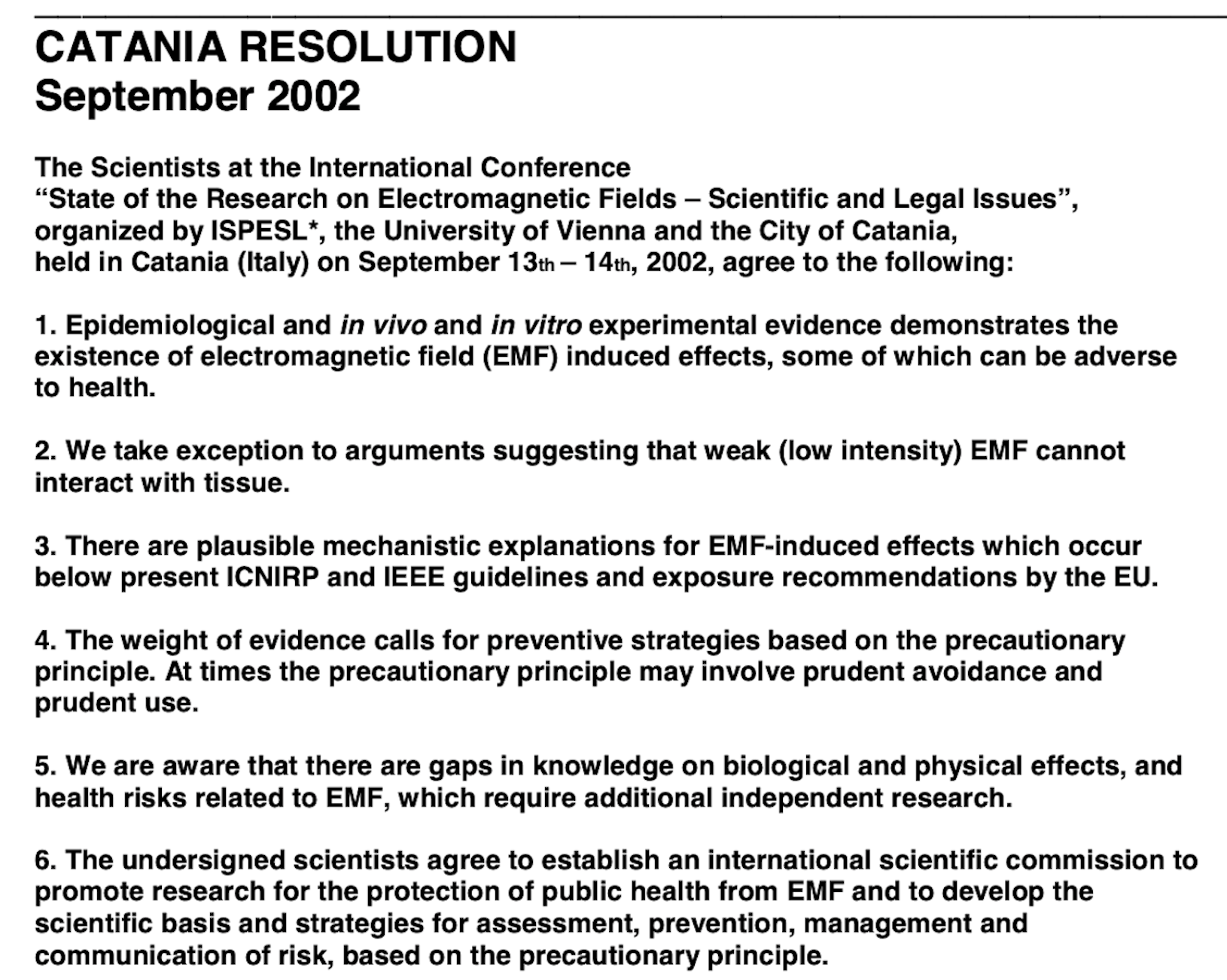 Click for Catania Resolution with signatories.
Click for Catania Resolution with signatories.
The following summer, 2003, ICEMS had its coming-out party at the annual meeting of the Bioelectromagnetics Society, held that year in Maui, Hawaii. In a poster paper presented at the conference, ICEMS leaders stated that, while they recognized the difficulties in deriving exposure limits, they objected to a “number of definitions and assumptions that have been made by ICNIRP and other standard setting bodies” [emphasis added].
ICEMS’ most consequential meeting was held in Benevento, not far from Naples, in February 2006. The organizers invited Repacholi, who in 1996 had become the head of the WHO International EMF Project in Geneva. He accepted. But it was not to be.
When word got out that Repacholi would be in Catania, an Israeli activist circulated a call that he be arrested there on a human rights violation —for failing to protect those suffering from electrosensitivity. The organizers informed Repacholi of the threat and he, in turn, told the UN police. He was advised to cancel.
“It’s a pity in a way, as I was always happy to listen to activists or scientists with alternative views.” Repacholi told me recently in an email from Western Australia, where he settled on retiring from the WHO.
Surprisingly, the UN sent a security team to Benevento even in Repacholi’s absence. There was no trouble, however. “The meetings went smoothly, and everybody enjoyed themselves,” recalls Elizabeth (Libby) Kelley, who was the managing secretariat for ICEMS at the time. Repeating this role, she is now ICBE-EMF’s managing director.
Later that fall, ICEMS issued a press release calling for greater protection from EMFs. It appealed for “a full and independent review of the scientific evidence that points to hazards from current EMF exposure conditions worldwide.”
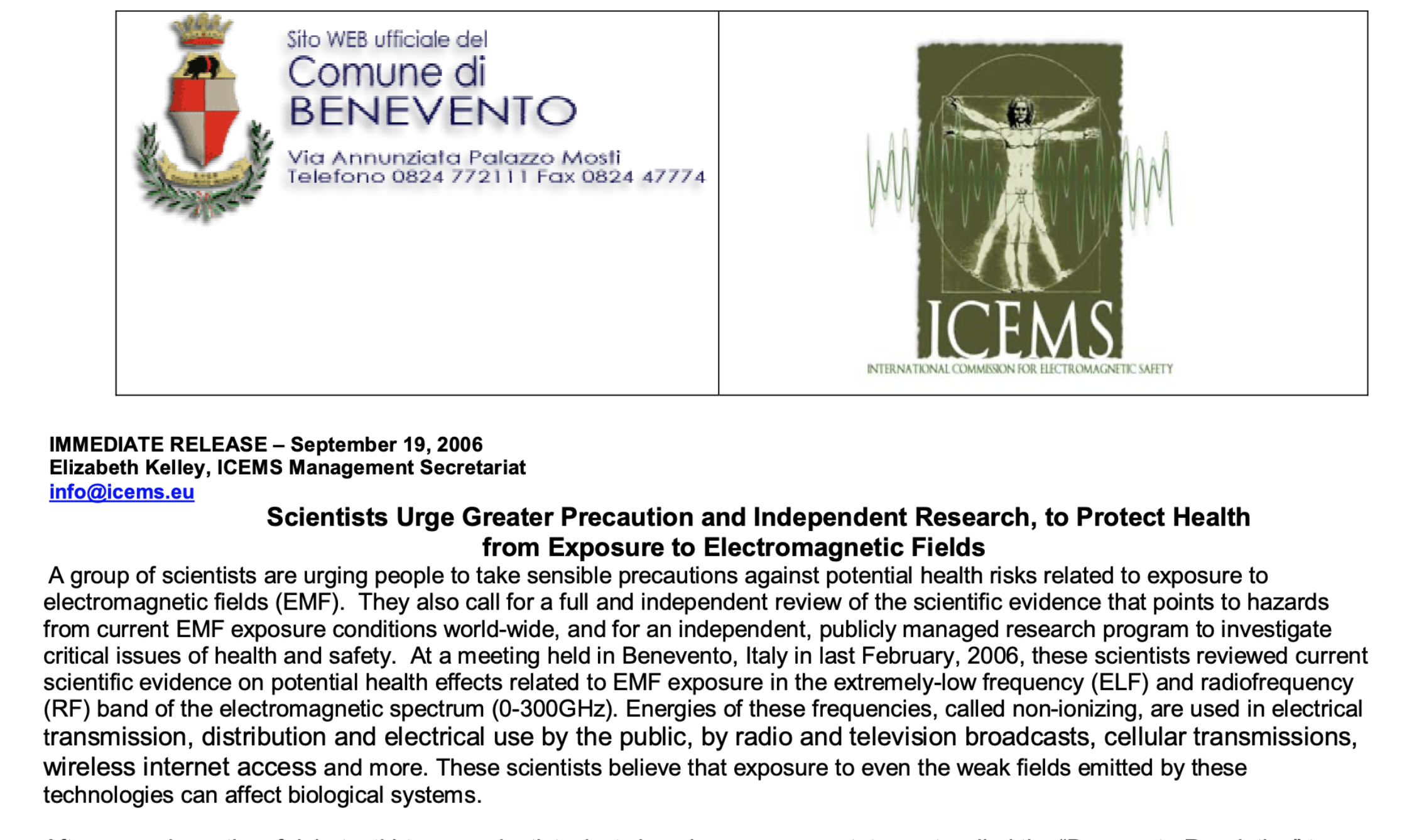 Click for full Benevento press release
Click for full Benevento press release
ICEMS held more workshops, including one in Venice the following year that prompted yet another resolution. But the group was beset by internal conflicts and unable to effectively compete with ICNIRP.
ICEMS slowly faded away. By the mid-2010s, it was little more than a memory.
Will This Time Be Different?
Might ICBE-EMF succeed where ICEMS failed? David Gee thinks it’s quite possible. A former senior advisor at the European Environmental Agency in Copenhagen and now one of ICBE-EMF’s special experts, Gee told me that the time is ripe for change. “I think the march of history is now moving, and more quickly, in our direction,” he said.
But Alvaro de Salles, an engineering professor in Port Allegre, Brazil, and an ICBE-EMF commissioner as well as an ICEMS veteran, said he’s “not optimistic.” In an email exchange, de Salles cited ICNIRP’s well-known “disdain” for low-level effects.
Dariusz Leszczynski, a semi-retired RF researcher and part-time blogger, took to Twitter to dampen expectations. The new commission is not the way forward, he advised, later adding, “We need consensus, not another commission.”
I asked Jim Lin, a professor emeritus at the University of Illinois who was an an ICNIRP commissioner for 12 years (2004-2016), why it has been so difficult to challenge its exposure limits. “ICNIRP has benefited from its close association with the WHO though the EMF Project,” he said. “The international stature of the WHO has helped ICNIRP resist external pressures to change.”
In a rare swipe at his former colleagues, Lin has chastised ICNIRP for quibbling over the NTP findings. “The simultaneous penchant to dismiss and criticize positive results and the fondness for and eager acceptance of negative findings are palpable and concerning,” he wrote last year.
Subsidies from German Government
ICNIRP has another major advantage: It has always received generous financial backing from the German Federal Office of Radiation Protection, known as the BfS.
In recounting the history of ICNIRP’s first 25 years, Repacholi acknowledged the unstinting support of the German government:
“Very important to the Commission’s budget and long-term operational stability was the granting of financial support by the German government for the running costs of ICNIRP’s Scientific Secretariat, a subsidy for travel, and funding for document editing and printing. ICNIRP was incorporated as a charitable, non-profit society in Germany in January 1994.”
As Microwave News reported two years ago, the BfS gave ICNIRP hundreds of thousands of euros between 2015 and 2019. The subsidies are most likely continuing.
The BfS has also favored scientists who, like ICNIRP Commissioners, deny the existence of non-thermal effects. No one more so than Germany’s own Alexander Lerchl. The radiation office has showered him with millions of euros in grants. (When Lerchl’s own research for BfS indicated a cancer risk, they downplayed it.) Similarly, the BfS has funded Bernard Veyret’s lab in Bordeaux, while withholding money from others who reported low-level effects. Veyret, a denialist like Lerchl, was on ICNIRP for 12 years (2000-2012).
The close relationship between ICNIRP and the BfS goes beyond money. It’s as if ICNIRP is a subsidiary of the BfS. The BfS building in Salzgitter, not far from Hannover, serves as ICNIRP’s institutional home and official mailing address. A senior BfS manager, Monika Asmuss, was a full member of the Commission from 2016 to 2018.
ICBE-EMF has no such benefactor. It does acknowledge a grant from the Electromagnetic Safety Alliance to cover the publication costs of the Environmental Health paper. The Alliance is a small non-profit based in Tucson; Kelley is its executive director.
Mounting Criticism
As David Gee points out, ICNIRP seems less untouchable now than it did a few years ago. Things began to change in 2019 after Investigate Europe —a team of reporters from across the continent— ran an in-depth exposé. Their verdict was blunt: ICNIRP is a cabal, a close-knit “circle of insiders” who dismiss research which others consider alarming.
The following year, two members of the European Parliament, Germany’s Klaus Buchner and France’s Michèle Rivasi, issued a scathing, 98-page report on ICNIRP with the title, “Conflicts of Interest, Corporate Capture and the Push for 5G.” They called the Commission “one-sided” and lacking the medical qualifications to evaluate the health risks. They wrote:
“As many scientists and critical observers have pointed out, it seems that ICNIRP members are either oblivious to, or are ignoring, scientific studies that find possible adverse health effects in the absence of heating.”
More recently, the pace of criticism has picked up. Here are a few examples:
- This June, two Norwegian researchers published an analysis of the most recent (2020) revision of ICNIRP’s RF guidelines in the journal Reviews on Environmental Health. They decried what they called ICNIRP’s “self-referencing authorships.” Else Nordhagen and Einar Flydal showed that ICNIRP people were involved in all the literature reviews used to “underpin” the new guidelines.
- In July, a German group called the Kompetenziniative —the Competence Initiative for the Protection of People, Environment and Democracy— released a hard-hitting, 26-minute video titled “War Gaming for Profit: Mobile Radiation, Cancer Risk and Industry Lobbying,” which amplifies the concerns raised by Investigate Europe. The original German-language version of the video was released in 2019 by Diagnose:Funk, a German-Swiss environmental group. It, in turn, was based on a 2016 documentary, “Thank You for Calling.” All three were directed by Klaus Scheidsteger. (Buchner is a member of the Kompetenziniative, as is Scheidsteger.)
- In a commentary published a week ago in the journal Frontiers in Public Health, Spanish scientists rebuked ICNIRP for not taking into account “effects not related to temperature increase.” These effects, they noted, have been reported in “numerous” animal and cell tissue studies.
And now, on October 31 (Halloween), as I get ready to post this story, Jim Lin has put even more distance between himself and his former ICNIRP colleagues. In a commentary published online today in Frontiers in Public Health, Lin endorses both precaution with respect to RF exposures and an upgrade of IARC’s cancer risk from ‘possible’ to ‘probable’.
“There are consistent indications from epidemiological studies and animal investigations that RF exposure is, at least, probably carcinogenic to humans,” he states. “The principle of ALARA—as low as reasonably achievable— ought to be adopted as a strategy for RF health and safety protection.”
_________________________________
The founding members of ICBE-EMF are:
Commissioners: Igor Belyaev (Slovakia), Carl Blackman (U.S.), Suleyman Dasdag (Turkey), Alvaro de Salles (Brazil), Claudio Fernandez (Brazil), Paul Héroux (Canada), Kavindra Kesari (Finland), Henry Lai (U.S.), Ronald Melnick (U.S.), Anthony Miller (Canada), Igor Yakymenko (Ukraine).
Special Experts: Kent Chamberlin (U.S.), David Gee (U.K.), Lennart Hardell (Sweden), Don Maisch (Australia), Erica Mallery-Blythe (U.K.), Albert Manville (U.S.), Joel Moskowitz (U.S.), Wenjun Sun (China).
Managing Director: Elizabeth Kelley (U.S).
https://microwavenews.com/news-center/new-challenge-icnirp
Spread the word:
- Click to share on Facebook (Opens in new window)
- Click to share on Twitter (Opens in new window)
- Click to share on WhatsApp (Opens in new window)
- Click to share on LinkedIn (Opens in new window)
- Click to share on Pinterest (Opens in new window)
- Click to share on Reddit (Opens in new window)
- Click to share on Tumblr (Opens in new window)
- Click to share on Telegram (Opens in new window)
- Click to print (Opens in new window)


